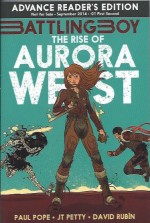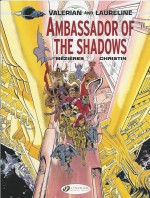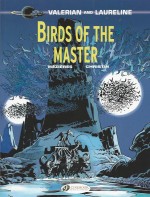
By Xavier Dorison & Mathieu Lauffray, translated by Jerome Saincantin (Cinebook)
ISBN: 978-1-84918-062-7
British and European comics have always been much more comfortable and imaginative with period piece strips than our American cousins and far more comfortable when reinterpreting classical fiction for jaded comicbook audiences. The happy combination of familiar exoticism, past lives and world-changing events blended with drama, action and, most frequently, broad comedy has resulted in a uniquely narrative art form suited to beguiling readers of all ages and tastes.
Our Franco-Belgian brethren in particular have made an astonishing success out of repackaging days gone by and this particularly enchanting older-readers yarn forgoes the laughs whilst extending the adventures of literature’s greatest rogue into a particularly engaging realm of globe-girdling thriller.
Robert Louis Stevenson’s Treasure Island was originally serialised from 1881-1882 in Young Folks magazine as Treasure Island or, the mutiny of the Hispaniola, written by the pseudonymous Captain George North.
It was collected and published as a novel on May 23rd 1883 and has never been out of print since. A landmark of world storytelling it has been dramatised innumerable times and adapted into all forms of art. Most significantly the book created a metafictional megastar – albeit at best an anti-hero – as immortal as King Arthur, Sherlock Holmes, Tarzan or Superman.
Almost everything the public “knows†about pirates devolves out the book and its unforgettable, show-stealing star Long John Silver…
Writer Xavier Dorison (Le Troisième Testament, Prophet, Sanctuaire, W.E.S.T.) was born in Paris in 1970 and graduated business school before moving into storytelling. He works as author, film writer, lecturer and movie script doctor. He began the award-winning Long John Silver in conjunction with Prophet collaborator Mathieu Lauffay (Oath of Amber, Axis Mundi) in 2006, with the fourth volume released in 2013.
Lauffay is also a Parisian born in 1970. He spends his days illustrating, drawing comics, crafting RPGs and working as a concept designer for movies. His art has graced such international items as Dark Horse Comics’ Star Wars franchise, games like Alone in the Dark, the album Lyrics Verdun, February 21, 1916 – December 18, 1916, Tarzan and much more…
Their continuation of the piratical prince is a foray into much darker, more mature fare which begins some years after the affair of the Hispaniola; opening in 1785 in the vast inner recesses of the Amazon.
Far upriver, the expedition of treasure-hunting Lord Byron Hastings appears to have finally foundered after years searching for the lost city of Guiana-Capac at the very moment of his greatest triumph.
Meanwhile in England, Hastings’ profligate and wanton wife Lady Vivian is pondering the shameful, daily growing evidence of her dalliance with wealthy and so-very-generous neighbour Lord Prisham. With a baby in her belly and a husband gone for three years, she is considering having Byron declared dead and a hasty remarriage…
Suddenly shattering all her plans is her despised brother-in-law who turns up at the door with an old native named Moxtechica bearing a message – and a map – apparently from her long-lost husband.
Prudish Royal Naval officer Edward Hastings delights in telling the scheming strumpet he abhors that his brother has succeeded but now needs more funds. She is to sell everything – including all the treasured family possessions, manor house and lands she brought to the marriage – to raise £100,000.
To ensure this the absentee Lord has named Edward as sole Proxy and the martinet delights in giving the high-born trollop her marching orders. He strongly urges her to confine herself to a convent and save them all further shame and disgrace…
Raging in front of her conniving maid Elsie, Lady Vivian considers a number of retaliatory tactics before settling upon the most bold and dangerous. After announcing to the stunned Edward that she will accompany him to South America and reunite with her beloved husband, the fallen noblewoman seeks out a doctor to take care of the “problem†she is – for the moment, still secretly – carrying…
Dr. Livesay is a decent god-fearing soul who has led a quiet, prosperous life since his adventures on Treasure Island. However it is not her current condition which has brought Vivian to the learned man’s door, but rather persistent tales of his scurrilous former acquaintance: a formidable, peg-legged rogue with a reputation for making life’s difficulties disappear…
Against his better judgement, Livesay capitulates to the Lady’s urgings and takes her to Bristol to meet retired sea-cook and owner of the Spy Glass tavern, John Silver.
Amidst the (alleged) former pirate’s inner circle of scary-looking confederates she relates the story of the Spaniard Pizarro‘s discovery of a City of Gold and how, centuries later, her husband has found it.
The rest of her sorry tale tumbles out and her plans to travel there with a few capable men – and the far from willing Elsie – to make the riches her own…
All she needs is for Silver and his colleagues to infiltrate Edward’s crew, seize the ship he intends to charter and complete the voyage under her command…
Livesay is outraged but, unable to convince Vivian to desist or Silver to reject her offer, the chivalrous sage joins them in a vain hope that he can keep the debased woman from mortal harm.
Edward has meanwhile commissioned a ship from the unsavoury Samir Razil. “The Ottoman†has his own plans in play but old associate Silver soon bloodily scuppers them. The sea-cook has never had any time or pity for slavers – even in the debilitated condition he strives so desperately to conceal from everyone around him…
With the Neptune now secretly under his control and having forced Lady Vivian to sign a sacrosanct Pirates Contract, the sinister scheme and the ramshackle vessel get underway with Captain Edward Hastings none the wiser. Livesay is increasingly concerned about Vivian’s pregnancy but the savage Moxtechica seems able to help her with strange brews that he concocts…
With all the players in place the Good Ship Neptune casts off into the icy channel under stormy skies, setting sail for the doom-laden Americas…
To Be Continued…
Moody, suspenseful and startlingly gripping, the further exploits of Long John Silver are a masterpiece of adventure fiction worthy of Stevenson’s masterpiece and might even convince a few more folks to actually read the original novel.
© Darguad, Paris, 2007 by Dorison & Lauffray. All rights reserved. English translation © 2010 Cinebook Ltd.










